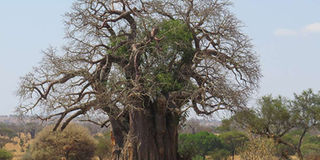Climate change killing off Africa’s iconic baobab tree

An elephant under a Baobab shade at Tarangire National Park in Tanzania. PHOTO | RUPI MANGAT | NATION MEDIA GROUP
What you need to know:
By using radiocarbon dating, the African baobab is known that some live over 2,000 years.
Their fruit is increasingly in demand as a new “super food” particularly in Britain, but also across Western Europe.
Large numbers of Africa’s most iconic tree – the Baobab – are dying, almost certainly as a result of climate change, according to a new report in a London-based journal.
The report in the journal, Nature Plants, said that its research had found that nine of the 13 oldest, and five of the six largest individual trees studied, had died in the past 12 years.
While the cause of their mortalities is still unclear, climate change is suspected.
“The deaths of the majority of the oldest and largest African baobabs is an event of an unprecedented magnitude,” the authors wrote.
“These deaths were not caused by an epidemic and there has also been a rapid increase in the apparently natural deaths of many other mature baobabs.
“We suspect that the demise of monumental baobabs may be associated at least in part with significant modifications of climate conditions that affect southern Africa in particular. However, further research is necessary to support or refute this.”
The African baobab is the biggest and longest-living angiosperm tree. By using radiocarbon dating, it is known that some live over 2,000 years.
Their fruit is increasingly in demand as a new “super food” particularly in Britain, but also across Western Europe.
But the report suggests that the baobab’s future is under threat across sub-Saharan Africa, particularly in southern Africa as a result of the El-Niño phenomenon which has increased dry conditions in the past 20 years





